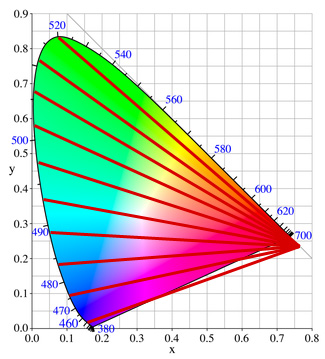When people hear that you are red-green colorblind, most of them think, that you can not distinguish between red and green. But that is wrong.
Of course, red and green are some of the problem colors when you are suffering from red-green color blindness. But…
- … some shades of red and green are easily to distinguish,
- … and many other colors also cause problems.
The following diagrams of the CIE 1931 color space can give you a quite good understanding of which colors are problematic for colorblind people.

All colors in the direction of the lines might be hard to differentiate. There are three different diagrams corresponding to the three main color vision deficiencies: protanopia (red-blindness), deuteranopia (green-blindness), and tritanopia (blue-blindness).
| Copunctal Point | x | y |
|---|---|---|
| Protan | 0.747 | 0.253 |
| Deutan | 1.080 | -0.800 |
| Tritan | 0.171 | 0.000 |
See Wyszecki & Stiles, Color Science (2nd ed.), 1982, Table 1 (5.14.2) p. 464
The lines shown above are called confusion lines and converge at a point which is called the copunctal point. For the three different types of color vision deficiency there are three different copunctal points.
For the two types of red-green color blindness (protanopia and deuteranopia) the main problem area of colors is really in the axis between red and green. And on this side of the color space, the confusion lines are quite the same for both types. This is why they are called red-green color vision deficiency. But on the left side of the diagram you can see that they are quite different confusion lines which show the problem colors.
If you would like to learn more about color matching and confusion lines you might like to read the article Color Matching and Color Discrimination by Joel Pokorny, a very well known researcher in the field of color vision deficiency.
As you can see from the above diagrams, the whole spectrum of colors is some way reduced for colorblind people. It is definitely not only red and green (protanopia/deuteranopia) or blue and yellow (tritanopia) which can not be distinguished.

Hi Brian,
I don’t know much about color blindness, but found your blog and wanted to learn more. I haven’t met one client who was color blind. I know Google is the jack of all trades. Wouldn’t it be nice if they could come up with a browser that could help you with this?
Hi Daniel,
I am investigating tools for colorblind people, and one of the things I would like to be able to code is to transform images as they are seen by various types of color blindness.
I’ve been looking into the math behind all of this, scouring the web, bought a couple of books on the subject (including the one you recommend), but I can’t find a reference as to the mathematical definition of the confusion lines. (I’ve seen the graphs you have on this page in a number of places.)
I notice from your site and from several others that you are using a lookup table. What’s the source of the data? Is there a good reference for the required transforms?
Any pointers you could give me would be helpful.
Thanks,
Marty
Marty, the graph is actually quite simple. Just take the x/y coordiantes of one of the confusion points and draw any line through it in the CIExy color space – and you have a confusion line.
Concerning the math of image transformation, I think they are all based on the same. As I don’t have them handy, follow the sources of Coblis and you’ll find them.
Hello
i would like to know please if the nagel anomaloscope is based on subtractive or additive color mistures for the realization of the Red and Green mixture field?
i am currently reading the visual perception book and i would like to know please more info about it as the CIE chromaticity diagram is not so clear for me.
thank you and best regards
Pingback: Designing accessible color spectrums Joshua Tauberer’s Blog
There was a wonderful add-on for Firefox, CBext, that is currently disabled as the authors have not updated it to work with the 4.0 version of the browser. It had a color test inside and would repaint the screen with colors that were visible to the individual. This add-on was a wonderful addition to Firefox and made viewing the web much easier for this protanope. I really would love to have it back…